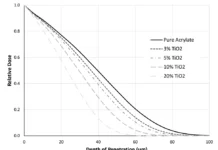By David A. Biro and Jim Bishop, Sun Chemical, USA
Abstract
Electron beam (EB) curing for wide web flexible package printing continues to evolve. Flexographic ink systems have been optimized to allow wet trapping of ink colors cured with a single electron beam unit after the last station in a central-impression press configuration. Long runs with stable printing performance are enabled by new press technology that includes temperature-controlled print stations. Web offset flexible package printing also is attractive given advances in variable repeat press technology. This includes the development of presses with offset print stations arranged in a central impression configuration. A comparison of EB flexo and EB offset printing technology will be presented. Both technologies allow for flexible package printing with near zero VOCs and low migration inks that are well suited for food packaging applications.
Introduction

Electron beam curing uses the high energy of accelerated electrons to directly cause the cross-linking of inks and coatings (Figure 1). Commonly, acrylate monomers, oligomers and prepolymers are used in many commercial applications. Other chemistries also are commercially available. The high energy of this curing process ensures that a high degree of conversion from oligomer to polymer takes place. The use of this actinic radiation occurs under inert atmosphere, such as nitrogen, to reduce ozone and other species generated under ionizing radiation. The non-oxidative atmosphere promotes a high level of cross-linking between the ingredients in the formulation. Increased crosslinking reduces free monomer and oligomer fragments to a level where the cross-linked product is acceptable for food packaging applications.
Characteristics of EB curing
A few key characteristics of electron beam curing include the following:
- Fast curing, up to 400 m/min
- Relatively “cold” process (Δ T ~ 5-10°C)
- Curing less affected by color or print density
- Electrons can penetrate deep into printed structures
- Cure inhibited by oxygen, nitrogen inerting required
- Cure under nitrogen reduces odor potential
- Ideally suited to web processes
- Wet-on-wet printing with a single curing unit at end of press
Some advantages of electron beam curing consist of the following:
- Electronically controlled dose rates – GMP/Assurance of cure
- Cured product exits the process “sterile”
- No photoinitiators
- Lower energy consumption
- Low heat (IR) radiation on substrate or central impression cylinder
- Low maintenance means less down time
While some disadvantages are comprised primarily around the influence on the substrate, such as:
- Discoloration of some polyamide (PA), PVC, OPP formulations
- For PE, the heat seal temperature of the thermoplastic can be increased.
- For OPP, the hot tack window could be altered.
- Some plastic films may be subject to chemical breakdown products under electron beam radiation.
- Some chlorinated substrates suffer from odor effects.
- Electron beam installations require a higher investment cost, but less maintenance and lower operating costs balance out the equation.
EB offset
Electron beam curing on lithographic offset presses has been around for about 30 years, predominately for folding carton and multiwall aseptic packaging applications. The applications are roll-to-roll or roll-to-diecut applications. The application is wet-on-wet lithographic printing, similar to conventional web offset heatset or conventional sheet fed printing, except that the inks and coatings are curing via electron beam rather than heat or oxidative drying. There is no interstation curing (although some presses have one to two UV curing units at the front of the press to perform additional converting). The substrate tension control can be a challenge.
Newer inline presses are equipped with variable repeat length designs, such as variable sleeves, to accommodate the requirements needed for the flexible packaging printing market. One new central impression (CI) offset press is the first one of its kind to use the film handling capabilities that are commonplace in solvent flexographic presses.
In general, the cost of offset plates is lower than the cost of flexo plates, making lithographic offset electron beam curing an attractive alternative to flexography for the flexible packaging printing market. This has been a growing area since 2006.
EB flexography

Traditional flexographic printing presses come in three formats: inline, stack and central impression. High-quality graphics on wide web flexible film for food packaging are traditionally associated with large central impression flexo presses. Some printers and converters have modified or removed dryers and replaced them with UV or EB curing units to remain flexible in their operations (Figure 2).
Changing from solvent-based or water-based inks to UV/EB presents challenges; yet, many are interested in the quality and rapid curing of newer technology. Some central impression flexo presses with overhead dryers can be converted to EB flexo by replacing the dryer with an EB curing unit. Other changes, such as ink delivery and web handling, also are possible. This is a wet-on-wet application with no interstation drying. Several suppliers offer a technology with EB curing, and others are offering technologies with and without interstation drying.
The benefits are seen in high-quality graphics and chemically resistant inks suitable for high-speed wide web flexible film for food packaging applications.
Food packaging applications
For applications where extractables or low odors are essential, such as food and drug packaging, this process provides a high margin of safety. Electron beam inks and coatings generally do not contain volatiles, so emission control equipment that is used for water- or solvent-based systems is not necessary. Local regulatory standards should be followed.
Although EB inks and coatings can be formulated to have very low extractables, they do not have FDA approval for direct food contact. The products, like many conventional inks, can be used where a barrier exists between them and the food.
Despite the above mentioned cautions, electron beam ink curing is used to print on individual juice boxes, citrus juice and milk containing products in the folding carton format. Many are produced on web presses running commercially at 250 to 300 meters/min. For many customers, folding carton applications for food packaging are a large part of the business. The converted board or polycoated board usually is diecut inline using a platen or a rotary diecut device. The latter enables rapid finishing of the product. Several converters print on plastic films or paper/polyethylene extrusion laminates for products such as in-mold labels, label wrap stock, shrink sleeves or flexible food packaging. Food packaging application requires the use of inks and coatings which are suitable for the type of packaging involved.
Following are some examples of use today:
- Folding carton. Predominantly in the US on boxes for dry foods, cereals, pasta, etc.
- Liquid and ice cream packaging. Coated board with EB inks in conjunction with extrusion lamination or UV or EB overprint varnishes
- Pet food bags. Multiwall paper bag or film construction for dry pet food (UV and EB)
- Shrink sleeve labels. A range of films (PP, PE, PET, PVC and OPS) with reverse-printed EB inks with a gravure applied solvent last down white ink
- Wraparound labels. A range of films (PP, PE, PET, PVC and OPS) with surface printed EB inks
- In-mold labels, yogurt lidding, cold seal snack food, etc.
- Emerging use in short run flexible packaging, surface and reverse printing, including lamination (PP, PET mainly today)

Nonsensitive packaging is where the product is not food or there is a functional barrier between the ink and the packaging. Example: multi-wall fruit juice containers, spices or soup package mixes. Sensitive “indirect” packaging is where the food is not in direct contact with the packaging material, but there is no safe barrier between the packaging and food. Cereal or snack food boxes would be examples. Sensitive “direct” involves packaging the food in physical contact with the inner (unprinted) side of the packaging. Examples include orange juice and milk containers, such as gable top polyboard boxes (Figure 3).
An understanding of the packaging material and how it is processed is important when considering the effects of ink and coating component migration. The types of migration include the following:
- Penetration migration. Migration from the printed side through the substrate onto the unprinted side.
- Contact migration. Migration from the printed side to the unprinted side of another sheet or stack or roll.
- Evaporation migration. Migration due to the evaporation of volatile materials by heating (heating, cooking or boiling the frozen products in its original packaging.
- Distillation migration. Migration through steam distillation by baking, cooking or sterilization.
The first two forms of migration are the most commonplace. The latter are less common, but the construction of the package and decoration are important so as not to have any negative organoleptic events. Judicious selection of inks and coatings, along with the substrate, is an important cooperative opportunity between suppliers and converters. Understanding the limits of electron beam curing is important when considering flexible package printing. Namely, is the final package printed/coated with wide web EB curing suitable for the down lane converting, filling, packaging, transporting, warehousing, display, consumer handling and storage? These are normative considerations, yet normal in many converted film and carton products for food packaging. This means open dialogue regarding the current state (conventional solvent flexo) of converting vs. an alternative (such as EB flexo or offset).
Trends and technology developments
Technology developments in energy curing include small electron beam units for narrow web label printing and converting and the use of electron beam curing for ink jet, screen and gravure printing. The shifting marketplace to shorter runs and fast printing is coupled with high-quality graphics. Digital high-speed ink jet and other toner-based digital technologies will be lagging behind the 250 to 300 meter/minute existing EB curing flexible packaging market of today. But, they will catch up eventually – maybe even with the assistance of electron beam curing.
The flexo and gravure wide web presses will not go away. In fact, the flexo /gravure ratios across the globe are USA 80/20, EU 40/60 and Asia 10/90. This technology is used for wide web flexible film printing for common food packing. Electron beam cured litho and flexo are making their way into applications such as common food packaging, high end laminates and lamination-look packages (i.e., using a high gloss coating to replace lamination). There will be more inline electron beam laminate structures as the technology evolves to control bond strength using novel chemistry and electron beam curing. Finally, combination printing with water- and solvent-based technologies (along with the EB litho and EB flexo technologies mentioned above) complement the current state of wide web printing.





